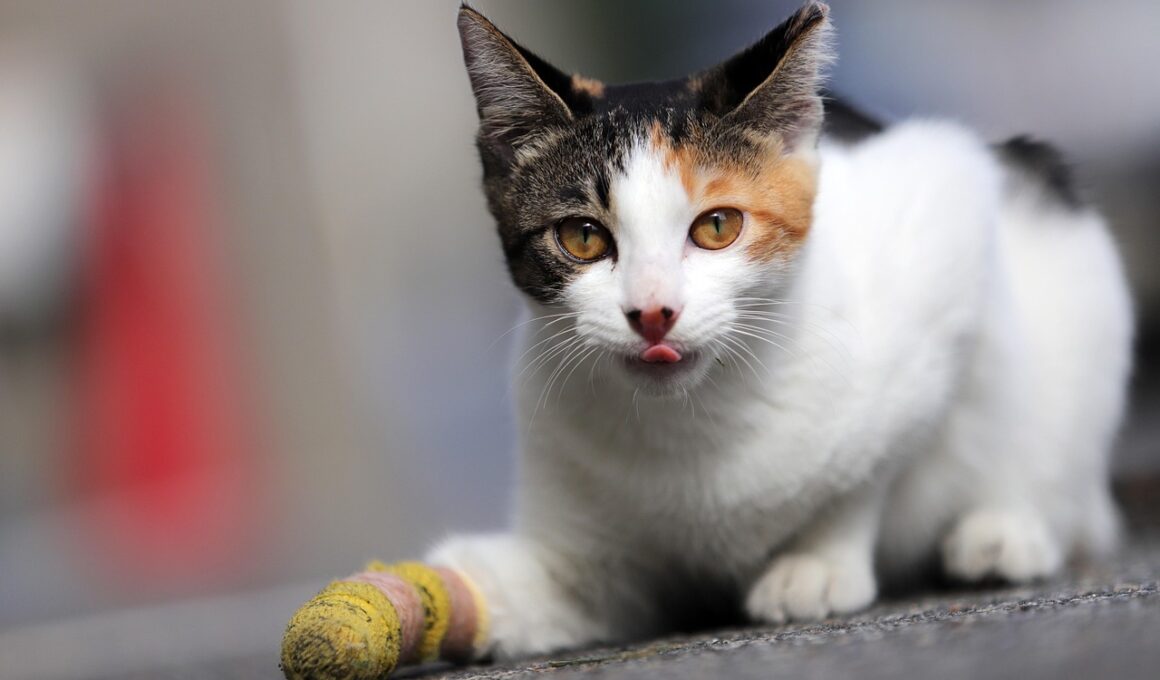How to Approach an Injured Cat in Outdoor Environments
Encountering an injured cat outdoors can be distressing for both the cat and the person. Cats, being naturally wary of humans, may react unpredictably when they are hurt. First, assess the situation carefully from a distance. Look for signs of injury, such as limping, bleeding, or unusual behavior. Ensuring your own safety comes first; do not rush in if a cat appears aggressive or fearful. Use a calm voice to reassure the cat. It’s important to avoid sudden movements that might scare it further. After you have assessed the situation, it may be prudent to consult with a veterinarian or local animal rescue service, especially if the cat’s injuries are severe. Consider if the cat is feral or domestic, as this impacts your approach. Creating a safe environment is vital; aim to reduce stress for the cat. Familiarize yourself with helpful tools like cat carriers or blankets that can provide comfort. Bringing a friend along can also be beneficial, as you will need assistance in managing the situation effectively and carefully.
Before attempting to approach the injured cat, gather supplies that may be useful during the process. A cat carrier, for example, is ideal for safely transporting an injured cat to a veterinarian. You can also use a thick towel or blanket to wrap the cat gently, minimizing further injury to them and protecting yourself from potential scratches. To help calm the cat, consider using soothing sounds, such as speaking softly or gently rustling a bag of treats, to help coax the cat towards you. It is essential to remain patient and take your time, as rushing could cause the cat to panic and potentially worsen its condition. Observe the cat’s body language closely; if it appears to be retreating or tensed up, slow down your movements. Additionally, create a non-threatening space for the cat to feel secure. Bringing a portable water dish may also help the cat feel more comfortable, especially if it has been separated from its owner for a while. Always remember that the priority is to provide a safe and supportive atmosphere for the injured cat.
Identifying Signs of Injury
Recognizing signs of injury in cats is fundamental to handling the situation effectively. Injured cats may display behaviors such as limping or reluctance to move. Some cats might vocalize more than usual, while others may withdraw entirely and hide. Look for physical signs such as blood or open wounds, any swelling, or favoring a particular limb. Also, monitor for any difficulty breathing, which may indicate serious injuries or internal trauma. Knowing these signs helps you take appropriate action when approaching an injured cat. Keep in mind that cats are resilient creatures; however, even minor injuries can lead to infections or complications if not treated swiftly. Therefore, responding quickly and effectively to these signs is essential. Providing the necessary first aid right after securing the cat will enhance its chances of recovery. When transporting the cat, aim for a quiet area where it can rest undisturbed. This approach helps to reduce emotion and anxiety for both you and the animal. Be gentle in your handling to further minimize stress; this is essential both for the safety of the cat and your wellbeing.
Once you’ve identified that the cat is injured and have approached safely, carefully assess how to transport it to safety. If the cat is feral, it might become aggressive when handling is attempted, so using a carrier will be your safest option. Place the carrier near to the cat without sudden movements and encourage it to enter by using treats or toys. If the cat doesn’t respond, gently nudge it with the blanket or towel to guide it inside, while ensuring you maintain your distance and avoid any bites or scratches. If the cat allows contact, wrap it securely in a towel to safely manage its movement. This is a particularly useful technique with scared or aggressive cats, preventing injury to both the cat and you. Keep your hands away from the cat’s head and face to avoid provoking panic. Remember, your main priority is getting the cat to veterinary assistance quickly but with care. Every minute counts when an animal is injured, but safety for both yourself and the cat should remain at the forefront of your approach.
Seeking Professional Help
As soon as you have secured the cat, your next step should be seeking professional help. Contact a local veterinarian or an animal clinic immediately and explain the situation, providing details on the cat’s observed injuries. Many clinics are prepared for emergencies, and knowing what to expect scientifically can help you remain composed. Some locations may even offer telemedicine services where you can receive expert advice prior to reaching the physical clinic. Additionally, local animal rescues often have resources available to assist with injured wildlife, including cats. They can provide you with further instructions on how to care for the cat while maintaining its comfort during your wait for professional help. Don’t hesitate to ask for advice regarding transport options, and consider arranging assistance from others who can help you carry the cat if necessary. Having someone with you can provide you additional support, to handle the cat or manage calls. Making a well-thought-out plan for transport ensures a smoother transition to medical care for the injured cat.
In case the cat resists getting into the carrier, you might need to employ additional techniques to calm it down. It’s helpful to create a familiar and inviting environment by bringing along personal scents such as towels or clothing that smell like home. This can ease the transition and reduce stress levels. Offer gentle encouragement but keep your interactions low-key. If the cat allows contact, you can slowly stroke its back or talk softly to it. Cats often benefit from familiarizing themselves with you before being secured. However, if the situation becomes increasingly tense, consider backing off to avoid deeper distress on the cat’s part. Pet stores sell calming aids, such as sprays that utilize pheromones and provide a soothing effect for anxious cats. Be aware of the cat’s reactions; if it is in too much pain, it may lash out despite calming efforts. This emphasizes the importance of patience. Each cat has unique preferences; some might respond better to soothing noises, while others may need more time to gather their wits before being approached.
Conclusively Supporting an Injured Cat
After successfully reaching the veterinary clinic, your role transitions to that of an advocate for the injured cat. Full communication with the vet team about what you observed is important, enabling them to deliver the best care possible. Provide any information you have about the cat’s behavior, symptoms, and any treatments you may have attempted. This includes any first aid measures, such as applying pressure to a bleeding area or immobilizing a limb. If the cat has identification tags or a microchip, mention this as well. Informing the team will help gather a complete picture of the situation quickly, allowing for more tailored care. Furthermore, continue to express your concern for the cat’s health throughout the session. Follow-up procedures might be necessary; ensure you receive clear instructions from the veterinarian for post-visit care if needed. Most importantly, remember that your actions significantly influence the cat’s recovery. Every step you take helps improve the chances of a positive outcome in a stressful situation, ensuring the cat gets the attention it needs promptly.
After an incident where a cat was injured and you assisted its recovery, consider ways to improve future interactions. Keeping a first-aid kit readily available can enhance your preparedness during emergencies. Research common feline health concerns in your locality, and stay informed about local veterinarians. Building relationships with animal clinics can facilitate smoother experiences in the future. Consider attending workshops on animal care or first aid, which can provide valuable knowledge that may save a life someday. Additionally, find resources within your community to promote responsible pet ownership; this can include awareness around cat safety in outdoor settings. Advocating for safer environments contributes to lower incidences of injury. In case you encounter another injured animal, remember the techniques you applied before. Revisit your notes on safe handling and transportation; each experience equips you with better strategies. The act of helping injured animals not only improves their likelihood of recovery but can also deepen your bond with the animal community. Supporting feline health ensures a long-lasting implication on their wellbeing and promotes a generally healthier environment for all pet owners.


